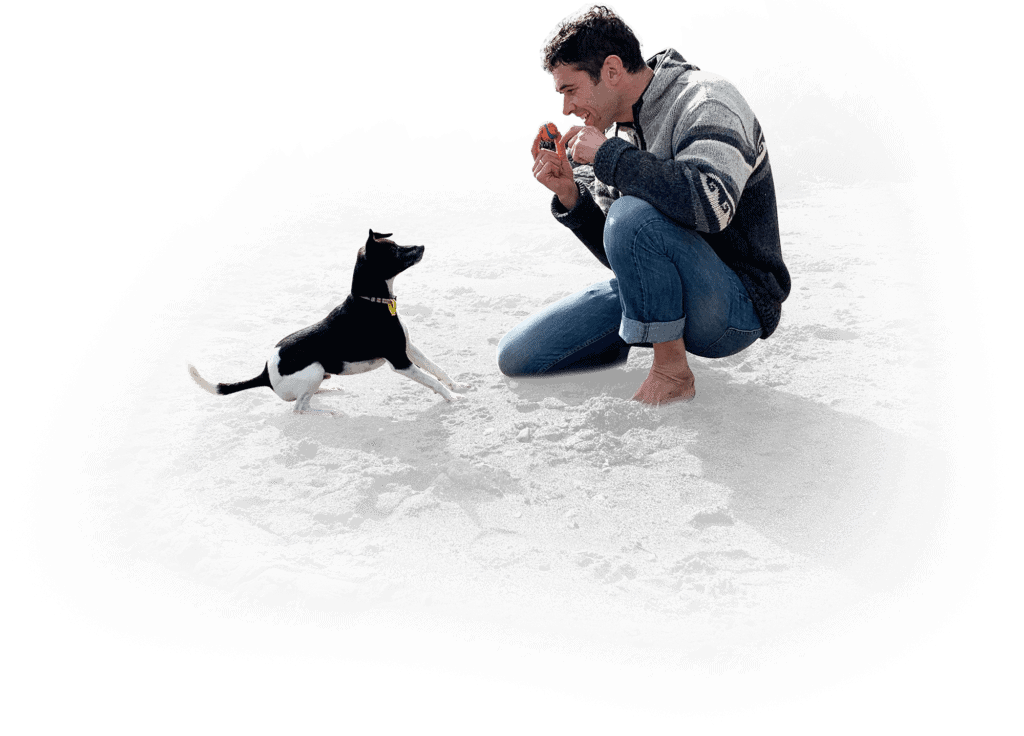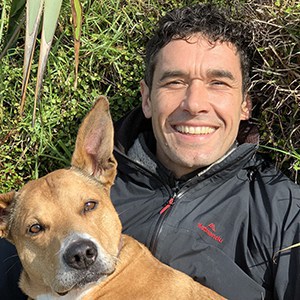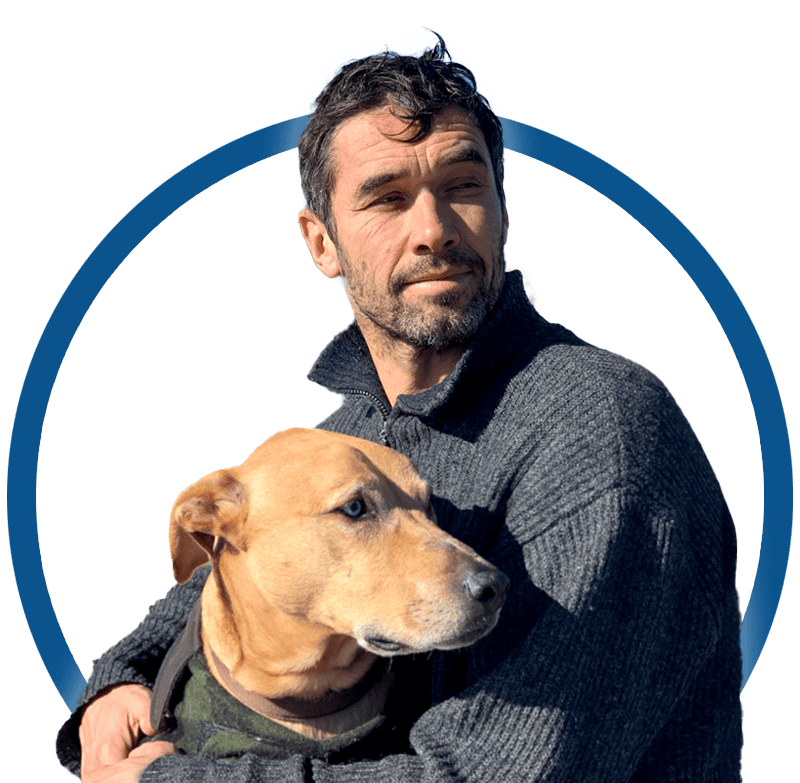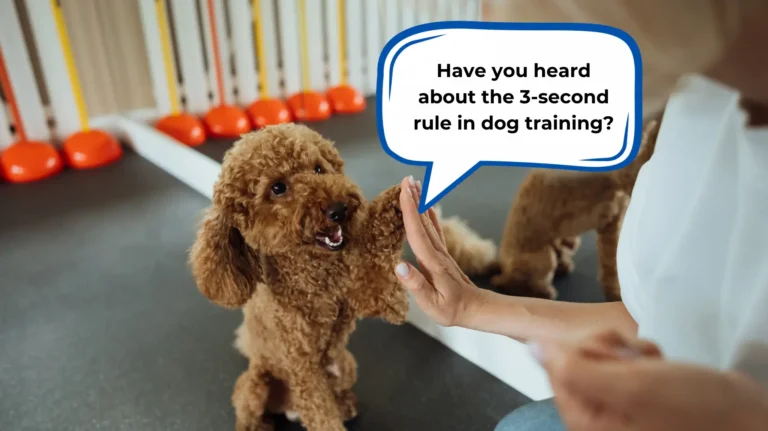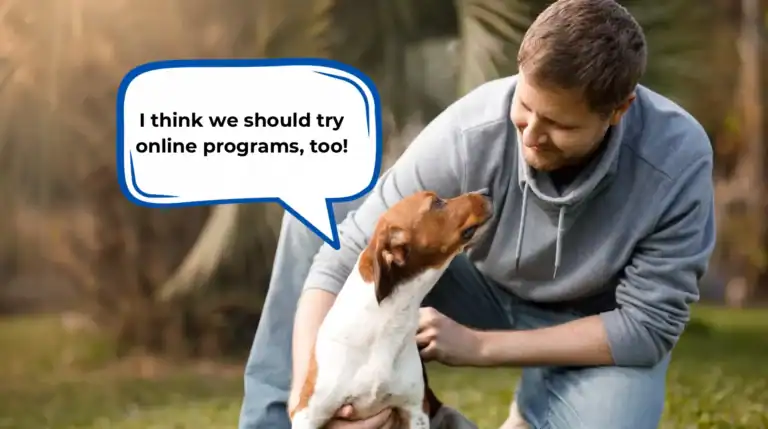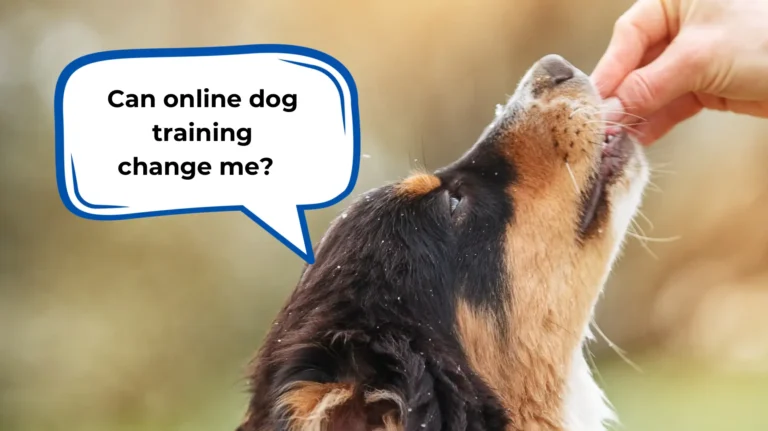Rule Number Two of the Doggy Dan Five Golden Rules always surprises dog owners who are new to the concept. If viewed through the lens of human psychology, Rule Number Two can make any dog owner go “But oh, isn’t that going to hurt my dog’s feelings?”
After all, Rule Number Two is about delaying acknowledgement after a moment of separation from your dog.

As a trainer who has seen the Five Golden Rules successfully adopted by over 88,000 dog owners, I’m here to tell you that in the eyes of your dog, observing Rule Number Two is ESSENTIAL in gaining their respect and love.
And no, it will not hurt their feelings 🙂 The reason they’re demanding attention everytime you reconnect has nothing to do with showing love.
In this blog, I’m going to share what’s behind Rule Number Two and why it’s a crucial foundation for your dog training and dog care journey.
Key Takeaways:
- In the eyes of your dog, observing Rule Number Two is important in gaining their respect and love.
- Even though our dogs have now become domesticated, they are still trying to test our leadership after every separation. It’s hard-wired into their genes.
- Not giving attention immediately after separation can be a powerful way of shifting leadership from your dog to you.
JOIN MY FREE REACTIVITY CLASS
Table of Contents:
- Doggy Dan Five Golden Rules and Rule Number 1 Recap
- Doggy Dan Five Golden Rules: What Rule Number Two Is Not
- Rule Number 2 of the Doggy Dan Five Golden Rules: Delaying Acknowledgement After Separation
- The Story of a Dog Who Behaved Better After Getting Delayed Acknowledgement
- How Rule Number Two of the Doggy Dan Five Golden Rules Help You Win Your Dog’s Love and Respect
Doggy Dan Five Golden Rules and Rule Number One Recap
First of all, let’s talk about the Doggy Dan Five Golden Rules before we jump to Rule Number 2.
As a recap, the Doggy Dan Five Golden Rules serve as the foundation for both managing dog behavior and nurturing a strong, affectionate bond between you and your dog.
I made these POWERFUL rules as the backbone of my highly effective Dog Calming Code™ training program.

What makes the Doggy Dan Five Golden Rules different from other training methods?
Unlike the regular training route where the solution is usually to go for a quick fix for certain issues, the Five Golden Rules use dog psychology to uncover the root causes of the most common dog behavior problems.
These Doggy Dan Five Golden Rules tap into your dog's natural instincts by helping you THINK LIKE YOUR DOG!
LEARN THE DOG CALMING CODE (FOR FREE)
Remember: You can’t use human psychology, or child psychology, or a general approach to animal psychology. Dogs have a very unique way of seeing things; and this is where the Doggy Dan Five Golden Rules come into play.
The Five Golden Rules is different from ANY dog training strategy because it doesn’t just address behavior problems — it actually flips who is in charge in the relationship with your dog.
By showing leadership to your dog—in a way they understand—your dog immediately begins looking to you for direction and starts to follow your lead.
Once your dog starts listening and respecting you, you will start to see the effect of this shift! You will be surprised that this approach challenges traditional dog training by eliminating the need for constant food incentives, shouting or shock collars, or an overwhelming array of tricks. BUT IT’S STILL SO MUCH MORE EFFECTIVE.

The Dog Calming Code and the Doggy Dan Five Golden Rules promotes genuine understanding and connection — a strong foundation for a successful dog training journey!
Rule Number 1: Controlling the Food Recap
As discussed in the previous blog, the Doggy Dan Golden Rule Number One is all about controlling the food.
It’s important to note that the first rule does not simply talk about “feeding your dog” or “giving treats” but actually “controlling the food.”
The first rule uses the power of food to create the right dynamic in the relationship between you and your dog.
You might wonder “Can food really do that?” The answer is YES!
Why?
Because food is NUMBER ONE for our dogs. It is their reason for survival, and their number one motivation!
FOOD IS EVERYTHING FOR DOGS! And the one who controls the food and the one that eats first leads the pack.
FREE REACTIVITY MASTERCLASS
Rule Number One helps establish that by making your dog see you as their number one source of food. You’re the one controlling the food, meaning your dog’s ONLY access to food is YOU.

When your dog sees that you’re their number one source of food — not the crumbs and leftovers on the ground, or the scraps of food they’ve hidden underground — they will begin to see you as their life source. Their leader! The one they should respect.
And that totally shifts your dog from being the one in charge to one who needs to listen, obey, and depend on you — their leader!
Controlling the food is also knowing that the two meals you feed your dog per day is YOUR MOST POWERFUL TOOL in your dog training journey. You can teach lessons about food aggression, separation anxiety, and even barking just by showing through food that you are in charge.
You can learn more about Rule Number One here.
Doggy Dan Five Golden Rules: What Rule Number Two IS NOT
Before I proceed with going into the details of Rule Number 2, I’d like to add an important disclaimer: Rule Number Two does not mean you’re going to TOTALLY deny your dog affection.
You CAN still give as many kisses, cuddles, and hugs to your dogs. But just like in Rule Number One, affection and acknowledgement should be given ON YOUR TERMS, not theirs.

Let me explain…
Unless you have established a SOLID leadership base, your dog will NATURALLY think they’re in charge of you, the family, and the entire property. Taking on the role of the leader is second nature to dogs!
Now, your goal as a dog owner is to let your dog know that YOU ARE IN CHARGE. Not them.
And just like with controlling the food, the attention you give should be on your own terms.
GET MY 5 GOLDEN RULES FOR FREE!
You see, your dog will play so many games to get your attention after being separated from you. One of the MAJOR FACTORS is because they NEED to CHALLENGE you and your control.

This is a golden dog psychology nugget here: when dogs meet, they don’t see each other as equals. For dogs, leadership SHOULD ALWAYS BE SORTED OUT.
AND THEY SURELY DO THAT TO YOU!
When you reunite with your dog, what happens when you give in and respond to their barking, jumping, or whining?
THEY’LL THINK THAT THEY ARE IN CHARGE.
I know… giving a pat or a cuddle to your excited dog is a seemingly harmless gesture! You think you’re simply showing your dog love, right?
But even affection and attention not given in a proper manner can SEVERELY get in the way of your dog training AND dog care progress!
Of course, you set the rule when it’s time to give your dog affection (after they relax, stop barking or running around) but it’s important to remember that even giving affection should be on your own terms.
Rule Number 2 of the Doggy Dan Five Golden Rules: Delaying Acknowledgement After Separation
Now let’s go to the nitty gritty of Rule Number Two, which is delaying affection, attention, or acknowledgement after separation from your dog. It’s basically ignoring your dog for a short while once you reconnect.

Separation can either be short (a trip to the bathroom) or extended (long vacations). Some dog owners ask me “Can I consider a 10-minute grocery store run separation from my dog?”
In the eyes of your dog, yes, it is.
It’s Crucial to Delay Acknowledgement Because That’s How the Leader of the Pack Operates
Our dogs have 99.998% the DNA of a wolf, and this fact explains why Rule Number 2 makes sense.
Here’s why…
Wolves have a very systematic way of hunting for their food. When it is time to hunt for larger game like elk, deer, moose, or caribou, the pack usually separates — some wolves stay to watch over the pups, while the stronger wolves hunt.

What happens after every hunt is really interesting: wolves do a kind of roll call to check on those who went for the hunt. Hunting for large prey often takes its toll on even the strongest wolves, so the roll call is a way for the pack to assess if these wolves — Alpha included — are still fit to lead the pack. Or if new leadership needs to be put in place.
This checkup happens AFTER EVERY HUNT. Of course, wolves don’t want an injured Alpha to lead them — that would endanger the survival of the entire pack!
So every time they reunite with the pack leader, they must determine if the Alpha remains capable of leading and protecting them.
REVERSE REACTIVITY (FREE WEB CLASS)
Now, how does the leader of the pack show that they can still lead? By not letting other wolves challenge them with jumping up or trying to dominate them. The leader stands their ground — they can’t be fazed by any show of forceful challenge!

Even though our dogs have now become domesticated, they are still trying to test our leadership AFTER EVERY SEPARATION. It’s hard-wired into their genes.
When you reunite with your dog, they will TRY SO HARD to get your attention. In their minds, they are thinking “Hey there! Let’s see who is really in charge in this household because I think it’s me!”
But that’s not the message you want your dog to get. The very heart of The Doggy Dan Five Golden Rules is letting your dog know that “No, you’re not in charge. I AM.”
Rule Number Two of the Doggy Dan Five Golden Rules is a Powerful Foundation for Training and Caring for Dogs
Here’s another reason why keeping silent and ignoring your dog is worth those few precious minutes: you can teach BIG lessons in silence.
Just like the Alpha who has returned from a hunt, you have to show your dog YOU are capable of leading your pack. How? By protecting your space.
How do you protect your space?
Once you reunite with your dog, they will be all over you! They could be jumping up, barking, trying to get you to play with them, climbing onto you, or even nipping you!

It’s important that DOGS SEE that you cannot be challenged.
In those few moments where you show your dog silence, you are shifting the leadership hat from them to you. Additionally, your silence shows your dog that no matter how much they bark, or jump, or whine in front of you, they ultimately have to wait for YOUR CALL.
(I made a full video about this topic. You can watch the video below.)
The Story of a Dog Who Behaved Better After Getting Delayed Acknowledgement
Here comes the golden question: does Rule Number Two work?
Does ignoring your dog come with benefits? Or will it give more reasons for your dog to sulk and become distant from you?
Let me answer your question through a story.
I remember being approached by dog owners who had a really restless dog. You get the picture: dog jumps non-stop, barks at every passerby, and runs around in loops!
These dog owners had enough of their dog’s antics that they want to solve the problem once and for all.

Before visiting them, I already knew what the problem was: the dog thinks they are the leader of the house.
To test my hypothesis, the very first thing I did the moment I entered their home was to ignore the dog! I completely held back on acknowledging him.
Sure, the dog barked at me at first. But the barking immediately stopped after he saw that nothing can get me to react. Not their barking or their restlessness!
The dog’s owners could not believe their eyes! “He’s never done that before,” they said. For a moment, they thought it was because it was a different day, or the dog’s more relaxed because he was well-fed.
REACTIVITY SOLVED (NO FOOD, NO FORCE)
There was a moment when a stranger passed by and the dog did nothing! No barking or running!
His owners were even more surprised! “It could be the treats!” one of them said.
I politely told them that it was actually because of the fact that I ignored the dog. By simply not giving the acknowledgement he so demands, I switched the leadership from him to me.
All because I was silent and withheld attention for a few minutes!
This is how powerful Rule Number Two is!
How Rule Number Two of the Doggy Dan Five Golden Rules Help You Win Your Dog’s Love and Respect
I know it sounds ironic! I have had dog owners ask me “How can silence make my dog respect me? I am worried that it will just make him sad!”
And I totally get what you feel. I’ve seen thousands of dog owners who love their dogs so much hesitate to follow Rule Number Two!
But here’s a very important fact: dogs don’t think like us. They look at everything from the perspective of dog psychology.

Sure, your dog may sulk for a few minutes, but Rule Number Two will ABSOLUTELY make a shift in your relationship.
LEARN THE DOG CALMING CODE (FOR FREE)
Why?
Because dogs CRAVE leadership. They look for structure and authority. They will assume it if not given, but imagine if YOU are the one that gives your dog the leadership they’re looking for!
It will definitely give your dog that feeling of “Phew, now I can relax because I am safe and secure.”
Your dog will absolutely respect and love you for taking on the role of the leader!
Learn How To Use the Power of Silence and Ignoring Your Dog with the Dog Calming Code
The thing about Rule Number Two is it’s a completely accessible and FREE dog training tool. It’s also one of the most powerful strategies to establish leadership WITHOUT raising your voice or stressing out too much.

Using SILENCE and DELAYED ACKNOWLEDGEMENT the RIGHT way is a must because your dog will try so hard to make you bend. And if YOU or the people in your family don’t get it right, you can fall into the same bad behaviors, and that can stall your training process.
This is why the Doggy Dan Five Golden Rules is an integral part of my program, Dog Calming Code. Within my program, you can learn more about Rule Number Two and get answers to questions including:
- I know I should remain silent, but for how long?
- What do I do if my dog jumps up, challenging me?
- We have a sliding glass door where the dogs wait for us to let them in, do we wait until they are calm before letting them in or just open the door?
- Is it okay to tell our dog to sit immediately when we come in the door?
- So do I have to follow this routine every time I go into another room and then return?
- Do we have to do this forever?
- What can I do if my dog mouths/nips me for attention when I come in the room?
- What is a “mini leave” and what is it for?
Giving our dogs silence even for a few minutes is TOUGH so it’s crucial that you use the Dog Calming Code for guidance around the WHYs and the HOWs of Rule Number 2.
Because silence and a little tough love can tremendously change your relationship with your dog… for the better.

~ Doggy Dan

